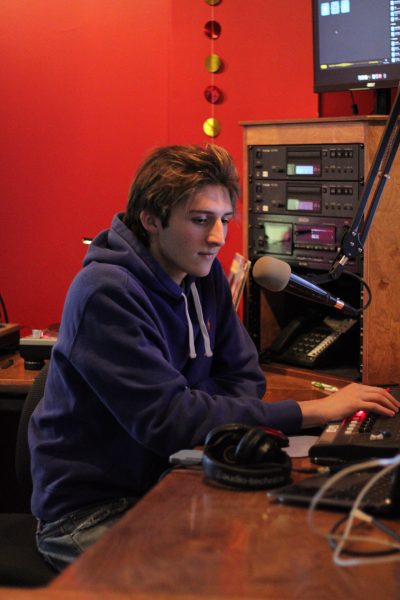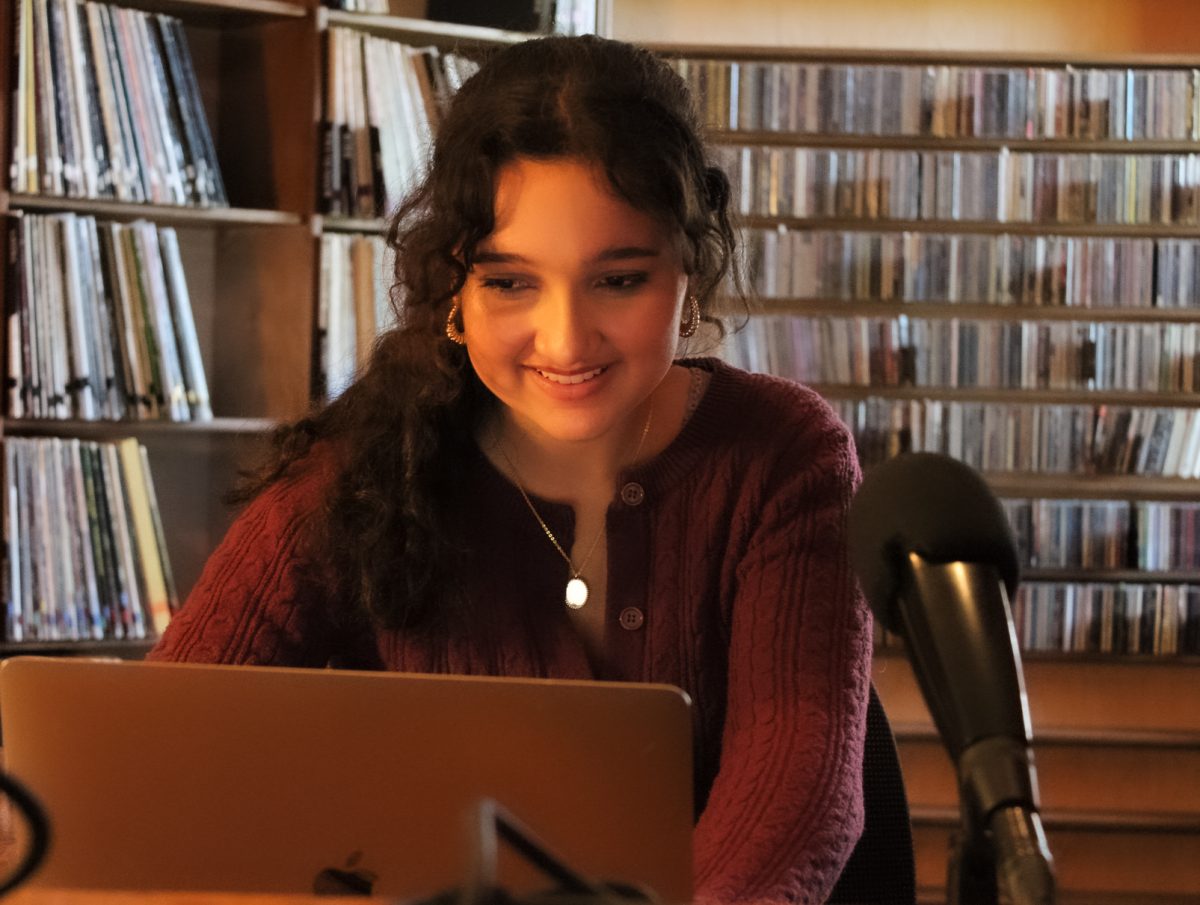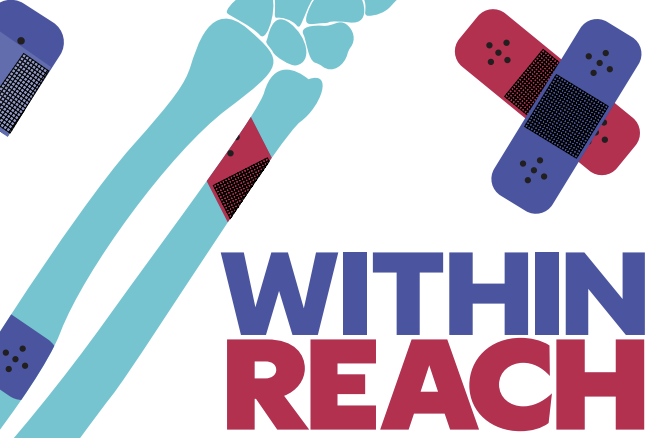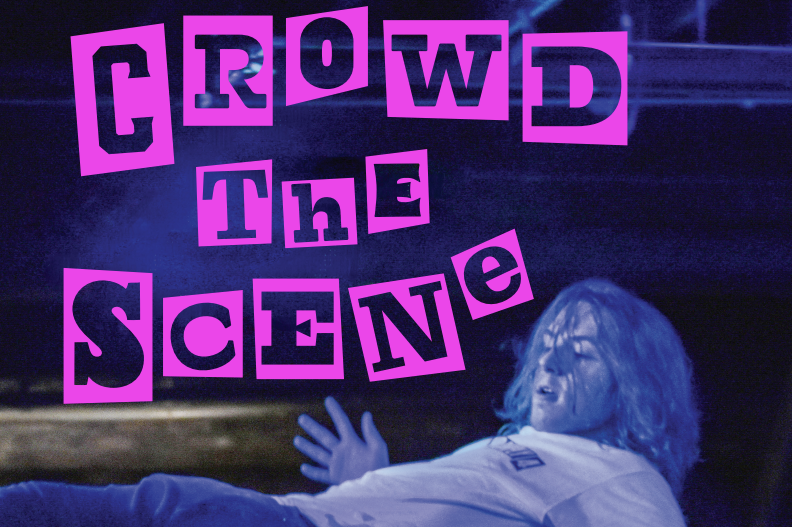“This is WXOX with Max Ca$h,” he said with a youthful, almost angelic voice. “And now, ‘Good Golly Miss Molly’ by Creedence Clearwater Revival.”
A rugged, guitar-heavy jam echoed through the lobby, engulfing the room a calm, creative vibe. Each musical note ricocheted between the red and gold decorations scattered across the ceiling.
Imitating the beat of the groove, a pulsing red light above the door to the main studio flickered “ON AIR” to signify that the show was in session. The energy flowed through the studio, every stroke of the guitar compelling the cluster of listeners in the lobby to sing along, even dance to the old tune.
As the song faded, one would assume the radio show would go in the direction of southern rock — songs guided by the spirit of Creedence Clearwater Revival. Instead, a new, persistent beat emerged, blended with a classical twist and a deep male voice. He switched to “née-nah” by 21 Savage, Travis Scott, and Metro Boomin. The complete musical transition from rock to rap might be unexpected to listeners, but was a standard feature of his radio show.
Max Selby, 16, whose DJ name is Max Ca$h, is a host on Louisville’s WXOX-97.1 FM, also known as ART FM, which is a noncommercial, short-range radio station. Selby is a junior at Louisville Collegiate School and goes on air after school every Wednesday from 4-5 p.m. on his show, “Emporium.” His unique style has harvested an eccentric sound for the citizens of Louisville to hear. He is one of many young creators at ART FM expanding the voices of youth in radio at a time when their listenership is lower than that of any other generation.
A 2018 poll by the Broadcast Performing and Research Center indicated that while radio was the most common music platform overall, only 12% of people ages 16-19 and 20-26 used it. For all age groups over 35, at least 30% of listening was through radio, making it the largest percentage among those groups.
Many attribute the decline of radio to the recent encroachment of digital media platforms like streaming services and podcasts. And in today’s age, radio is commonly associated with older generations. This leads young people to stray away from radio and pursue their listening with on-demand platforms like Spotify and Apple Music.
Even with radio prevalence decreasing, there are people in Louisville using their voices to captivate the city’s ears and invite listeners to grow their appreciation for radio. Their goal is to redirect the trajectory of an industry that has been on a generational decline.

On Air, Off Script
“My show is cohesively everywhere,” Selby said.
If the switch from rock ‘n’ roll to rap didn’t already showcase that, then the evaluation of his tracklist definitely did. Selby carries this musical spontaneity with him on every show and allows whatever he feels to be broadcasted freely through the airwaves.
“I grew up under the soundboard,” Selby said. “It’s always been in my life.”
His mom, Sharon Scott, is the owner and general manager of ART FM, so the radio station is a familiar environment for Selby. He has used his experience in the field to introduce listeners to new artists, sounds, and genres with the hope that they will come back every Wednesday. Even with his diverse arrangement of music and local support, Selby has acknowledged the reduction in radio’s media relevance.
“There’s definitely been a decline in the use of radio,” Selby said. “I think it’s been outshined and it’s not a dominant source of media anymore.”
Despite the shifting tides of media consumption, those at ART FM emphasize radio’s consistent presence in society.
“Whenever a medium comes along, they talk about the death of the old medium, and radio, throughout this whole thing, has stayed extremely strong,” said Scott.
This resilience speaks to the enduring appeal and adaptability that Scott has created at ART FM. By allowing many young creators on the radio, including Selby, she has nurtured an environment where self expression is encouraged and engagement in the community is required.
Scott, a long-time advocate for radio on ART FM, appreciates the station’s uniqueness and ability to connect with local listeners. But above all else, Scott’s favorite part about radio is a characteristic that distinguishes it from all other forms of media: accessibility.
“In a storm or a tornado, a lot of times the internet is one of the first things to go out, but the FM broadcast is much stronger,” Scott said. “There’s lots of instances you see in big, intense, tragic-type situations where the radio is the thing that holds people together and lets them know what they need to do.”
Radio is universal, whether it’s the source of immediate news, a song that can’t be skipped, or the background noise to a vibrant conversation. Its success has stretched beyond the lifespan of many other forms of media, even if it was dimmed by the temporary spotlight of other platforms at their peak.
“We are seeing between 200-400 folks streaming in from 20 different countries worldwide each day,” Scott said, reflecting on ART FM’s online listeners.
While ART FM is a live radio station, they’re able to reach a wider audience through online listening. This doesn’t account for the people listening directly through the radio. Scott explained that the online listenership is a fraction of the total number of participants tuning in to ART FM, but gathering data on live radio is very difficult.
Making Waves
A delicate violin reverberated through the speaker, the notes connecting from one to the other. Combined with light taps on the piano, it was the cherry on top to a relaxing Sunday afternoon.
The curator of these cohesive instruments was Lila Hayden, 16, also a junior at Louisville Collegiate School whose show, “L.A.M. Radio Hour,” airs classical music from 1-2 p.m. on Sundays at ART FM. “L.A.M Radio Hour” is a collaboration with the Louisville Academy of Music (LAM), and Hayden co-hosts the show alongside Colleen Mahoney, who is a violin teacher at LAM.
Skilled in the composition and history of classical music, Hayden co-hosts an hour of symphonic melodies and the dissection of archival greats.
Hayden’s specialization in classical music comes with a stereotype that is similar to that of radio — an old and outdated interest that once was popular. But her passion for this type of music ignites the means of her own self expression.
“Being able to bring many types of genres to people of all ages is really important,” Hayden said.
Catering to a wide range of musical tastes emphasizes the necessity of including youth voices in radio, ensuring that the programming remains relevant and engaging for younger audiences.
“When you listen to the radio, you don’t really hear teenagers talking — it’s strictly adults,” Hayden said. “So I think the fact that WXOX lets teenagers be on air is really valuable.”
WXOX’s emphasis on youth voice in radio is a major reason for its creative environment and diverse content. In fact, it is what attracted Elliot Lueken, 18, to WXOX in the first place.
Lueken, an Atherton High School senior, participates in a storytelling segment on WXOX called “The Sun Tastes Too Loud.” Reading various poems and short stories, like “Annabelle Lee” by Edgar Allen Poe, they convey a deep, personal connection to literary works while initiating intellectual conversations with their listeners.
“And radio is one of those things that, sure, there are generated stations or pre-recorded shows, but it’s made by people and put on by them,” Lueken said.
Their favorite part about radio is its authenticity, especially during a time of algorithm-based media and pre-recorded content.
“Radio is something that only happens once you hear it,” Lueken said. “To listen to someone talking and choosing their music in real time, it’s a very beautiful thing if you sit there and think about it. It can make you feel less lonely sometimes.”
Even with radio’s one-of-a-kind characteristics and historical adaptability, streaming services have surpassed radio in terms of revenue and youth listeners.
According to the International Federation of Phonographic Industry’s Global Music Report of 2023, music streaming services grew by 10.3% in 2022, taking over 84% of the United States’ music industry revenue.
Still, streaming platforms have dethroned radio on the media stage. In order for radio to captivate more listeners and remain a powerful medium, stations have to include content that appeals to all ages — not just older generations, who make up the bulk of their current audience.
“There’s a lot of work that needs to be done,” said Sylvia Goodman, the State Capital Reporter for Louisville Public Media (LPM) and former On the Record reporter. “And I think part of that is bringing in more youth voices. But it’s not just about getting youth voices on the radio, it’s about how you source your stories in the first place.”
This serves as a call to action for media professionals to prioritize inclusivity in storytelling, particularly by involving younger generations as primary sources in media.
“I think there’s this idea that kids aren’t interested in news and I think that anyone who’s been on Twitter or TikTok knows that’s not true,” Goodman said. “There’s hunger for information, accurate information and interesting information.”
By understanding the preferences and interests of young people in today’s society, radio can be a major facilitator in providing an always present, but new form of listening for youth. Stations like LPM and ART FM’s involvement of youth perspectives is vital for the success of radio’s future in Louisville.
As the steady beat of “Wolf Like Me” by TV on the Radio slowly faded away, Selby’s voice filled the airwaves once more. His signoff carried a sense of continuity, a promise of returning the following week and continuing the musical dialogue.
“This has been Emporium,” Selby said. “Thanks for listening. I’ll see you all in some time.”













